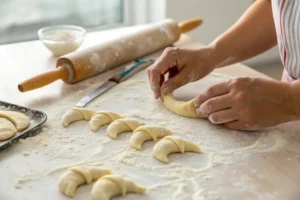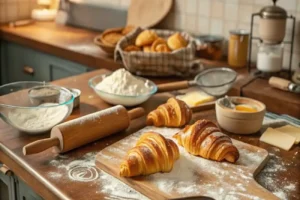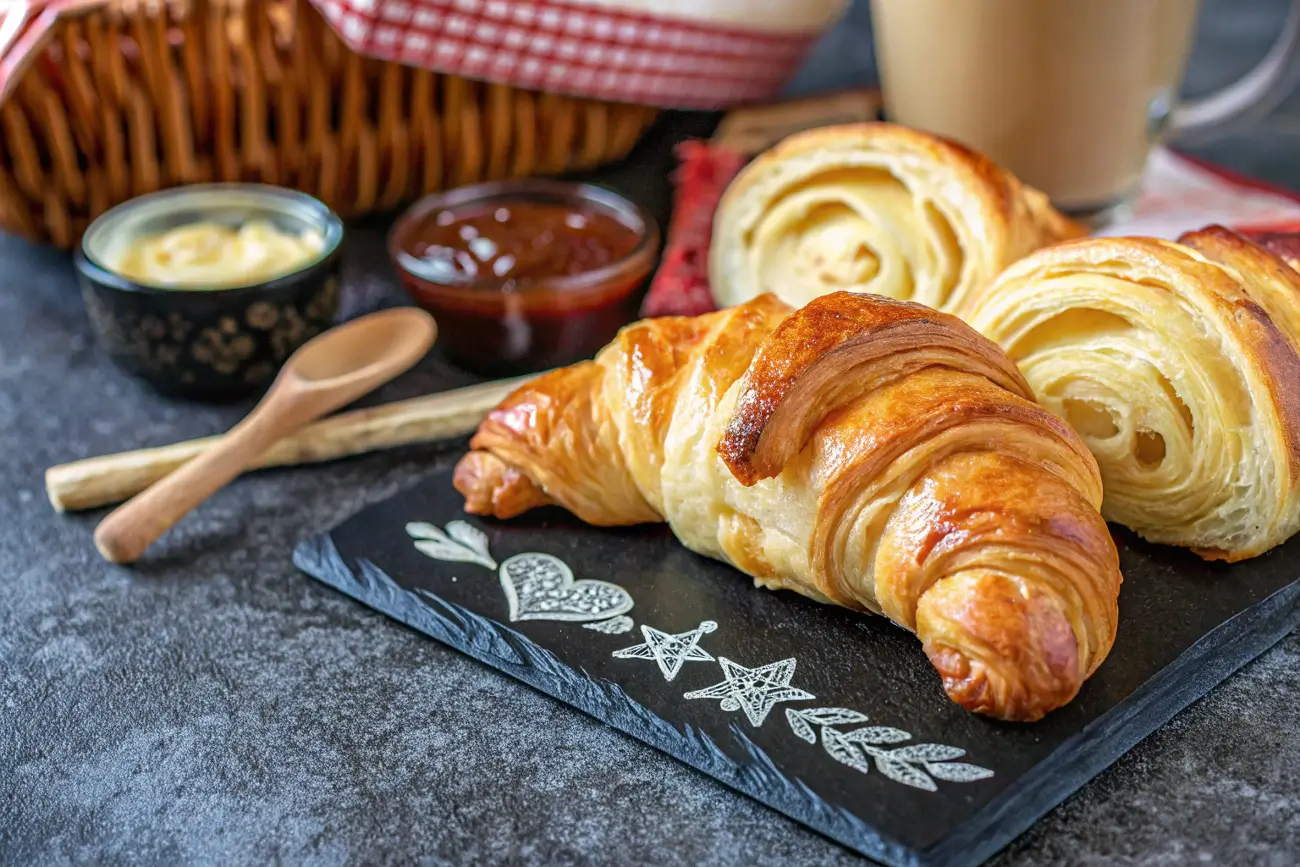Gipfeli Recipe: How to Make Perfect Swiss Croissants at Home
recrpeIn my Swiss grandmother’s kitchen, the smell of gipfeli recipe filled the air every morning. It made our simple breakfast feel magical. These crescent pastries are more than a recipe; they connect us to Swiss tradition and heritage.
Want to make the perfect gipfeli recipe? You’re in the right spot. This isn’t just any easy croissant recipe. It’s a real Swiss baking adventure that will make your breakfast better. The best gipfeli recipe combines skill and passion, offering flaky layers that are irresistible.
Swiss bakers have mastered this craft over many years. Gipfeli recipe are lighter and more delicate than French croissants. They have a unique texture that shows the Swiss attention to detail. This guide will help you make these amazing pastries, whether you’re an experienced baker or just starting out.
Ready to turn your kitchen into a Swiss bakery? Making gipfeli recipe from scratch will change your breakfast forever.
More delicious recipes. Check these out!
Understanding Gipfeli Recipe: The Swiss Croissant Variation
Ever wondered about the difference between a croissant and a gipfeli recipe? These Swiss crescent-shaped treats offer a unique taste experience. They stand out from French croissants in many ways.
Gipfeli recipe first appeared in Switzerland in the early 19th century. They are a special pastry with deep Swiss roots. Unlike French croissants, gipfeli recipe have a gentle sweetness. This makes them great for both sweet and savory dishes.
Origins and Cultural Significance
In Switzerland, gipfeli recipe are a beloved breakfast item. They show the Swiss love for precision and skill in cooking. While a croissant recipe might look similar, gipfeli recipe have their own special touch.
Key Differences from French Croissants
- Texture: Slightly denser than French croissants
- Flavor: Mild sweetness not found in traditional French versions
- Shape: Similar crescent shape, but with distinctive Swiss proportions
- Ingredients: Uses local Swiss dairy and flour
Traditional Swiss Breakfast Culture
In Switzerland, gipfeli recipe are more than just a pastry—they’re a cultural icon. They’re often enjoyed with coffee, jam, or savory breakfast items. These crescents show the Swiss dedication to quality and tradition in baking.
Essential Ingredients for Perfect Gipfeli Recipe
Making authentic Swiss gipfeli recipe means picking the right ingredients. Knowing what goes into these pastries is crucial. It helps you get that flaky texture and rich taste.

Your traditional gipfeli recipe needs a special set of ingredients. Let’s look at the key parts that make these Swiss pastries so delightful.
- All-Purpose Flour: 500g (3 1/2 cups) – The foundation of your dough
- Warm Milk: 250ml (1 cup) – Activates the yeast and adds moisture
- Unsalted Butter: 250g (1 cup) – Cold, high-fat content (82-85%) for ultimate flakiness
- Granulated Sugar: 50g (1/4 cup) – Provides subtle sweetness
- Active Dry Yeast: 7g (1 packet or 2 1/4 teaspoons) – Crucial for rising
- Salt: 1 teaspoon – Enhances overall flavor profile
- Egg: 1 beaten egg – Used for brushing to create golden shine
When picking ingredients for a croissant-style pastry, quality is key. Go for European-style butter with high-fat content and fresh yeast. Fresh ingredients make your gipfeli recipe go from good to amazing.
Remember, exact measurements and quality ingredients are vital for these delicate Swiss pastries. Each part has a role in making the perfect texture and taste.
Kitchen Equipment and Tools Needed
Creating a professional croissant recipe is possible without a fancy kitchen. With the right tools and some prep, your home kitchen can become a pastry paradise. Whether you’re making an easy croissant or Swiss gipfeli redcipe, the right equipment is key.
Must-Have Baking Tools
To make great gipfeli recipe, you’ll need a few essential tools:
- Large mixing bowls (2-3 sizes)
- Precise measuring cups and spoons
- Sturdy rolling pin
- Baking sheets (2-3)
- Parchment paper
- Pastry brush
- Plastic wrap
Optional Equipment for Professional Results
These tools can take your croissant recipe to the next level:
- Digital kitchen scale
- Bench scraper
- Silicone baking mat
- Proofing basket
- Instant-read thermometer
Preparing Your Workspace
Having a tidy workspace is vital for making croissants. Clear your counter, gather all your ingredients and tools, and make sure your surface is clean and cool. A marble or granite countertop is best for keeping temperatures low during lamination.
Pro tip: Keep your butter cold and your workspace clean. Success in pastry making is 50% preparation and 50% technique.
Step-by-Step Gipfeli Recipe
Making delicious gipfeli redcipe is easy. This simple recipe will show you how to make Swiss crescent pastries at home. It’s perfect for both new and seasoned bakers.
Here’s how to make gipfeli recipe like a pro, with exact measurements and steps:
- Prepare the Dough
- Combine 4 cups of all-purpose flour with 2¼ teaspoons of active dry yeast
- Add 1 cup lukewarm whole milk
- Mix in ⅓ cup sugar and 1 teaspoon salt
- Lamination Process
- Incorporate 200 grams of cold, high-fat butter
- Roll and fold the dough 3 times
- Chill between each folding session for 30 minutes
- Shaping Your Gipfeli recipe
- Roll dough to 1/8 inch thickness
- Cut triangles with 4-inch base width
- Gently roll from base to tip, creating classic crescent shape
- Final Preparation
- Let shaped gipfeli recipe proof for 30 minutes
- Preheat oven to 400°F (200°C)
- Brush with beaten egg for golden shine
Bake your gipfeli recipe for 15-20 minutes until they’re golden brown. You’ll get flaky, buttery pastries that feel like a trip to Switzerland!
Pro tip: Keep butter cold and work fast to keep layers perfect. Enjoy your Swiss pastries warm, with coffee!
Mastering the Lamination Process
Getting a good croissant involves mastering lamination. This technique turns simple ingredients into a flaky, delicious pastry. It’s all about paying attention to detail and controlling the temperature.
Butter is key in making those layers. It makes up almost half of the dough’s weight. Bakers suggest using butter with 82-86% fat content. Brands like Organic Valley and Plugra work best.
Creating Perfect Butter Layers
- Maintain butter block temperature between 52-61°F
- Keep dough temperature between 36-43°F
- Chill shaped butter for 20-30 minutes before use
Folding Techniques
Folding is crucial for lamination. A 3-fold technique creates 9 layers, while a 5-fold makes more complex layers. Each fold adds more butter layers, making the pastry flaky.
Temperature Control Tips
- Rest dough in refrigerator if it becomes resistant during rolling
- Proof pastries at 75-78°F
- Brush off excess flour to ensure proper layer adhesion
Mastering lamination takes time and practice. But knowing these details can improve your pastry skills. The main thing is to be patient, precise, and keep temperatures cool.
Shaping and Rolling Techniques
Learning to shape your easy croissant recipe is key to making authentic Gipfeli redcipe. The professional croissant recipe needs precision and careful technique. This is to get those signature Swiss crescent pastries right.
To start shaping your Gipfeli redcipe, you’ll need a sharp knife or pizza cutter. Here are the essential steps:
- Roll out your laminated dough on a clean, lightly floured surface
- Cut the dough into precise triangles with a base width of 3-4 inches
- Ensure each triangle has clean, straight edges
- Start rolling from the wider base towards the pointed tip
The secret to perfect Gipfeli recipe is keeping the tension even while rolling. Start at the base of the triangle, gently stretching the dough as you roll towards the tip. This method helps create the classic crescent shape of these Swiss pastries.
Pro tip for your professional croissant recipe: Slightly curve the ends of your rolled triangle inward to create the distinctive crescent shape. Don’t worry if your first attempts aren’t perfect – even slightly misshapen Gipfeli recipe will be delicious!
- Aim for uniform thickness when rolling
- Keep your workspace cool to prevent butter from melting
- Practice makes perfect with this easy croissant recipe
Remember, Gipfeli recipe are smaller than traditional French croissants, showing the unique Swiss baking style. Your shaped pastries should be delicate, with visible layers. This promises a flaky, buttery texture.
Proofing and Rising Guidelines
Mastering the proofing process is key to making perfect Gipfeli. Understanding how dough rises can turn an ordinary pastry into a delightful croissant. It’s all about the details.
Proofing is an art that needs patience and focus. A common mistake is rushing the rising or not keeping the right temperature.
Optimal Proofing Conditions
Make sure your Gipfeli dough rises well in the right environment. Important factors include:
- Temperature range: 75-78°F (24-26°C)
- Humidity: Moderate, around 70-75%
- Location: Draft-free area with consistent warmth
- Duration: First rise for 1-2 hours
- Second proof: 30-40 minutes before baking
Visual Indicators for Perfect Rise
Know when your dough is ready by looking for these signs:
- Dough volume doubles in size
- Gentle indentations remain when lightly pressed
- Surface appears smooth and slightly puffy
- Texture feels light and airy
Remember, patience is crucial for those light, flaky Gipfeli layers. Take your time, watch the conditions, and you’ll make amazing pastries every time.

Baking Temperature and Timing
Getting the croissant baking temperature and time right is key for those golden, crispy pastries. Your Gipfeli’s success depends on precise oven settings and careful monitoring.
The ideal baking conditions for crispy Gipfeli involve a few key steps:
- Preheat your oven to 375°F (190°C)
- Use a middle rack for even heat distribution
- Bake for 15-20 minutes
Why is my croissant not crispy? Often, it’s because of the wrong oven temperature or not enough baking time. Look for these signs of perfectly baked Gipfeli:
- Deep golden-brown color
- Flaky, layered exterior
- Crisp edges with a slight shine
Pro tip: Use an egg wash before baking to enhance the golden color and create a beautiful sheen. Brush gently with beaten egg for that professional bakery look.
Temperature control is everything. Too low, and your Gipfeli will be pale and soggy. Too high, and you risk burning the delicate layers. Stick to the recommended 375°F, and you’ll create pastries that are crispy on the outside, tender on the inside.
Troubleshooting Common Issues
Baking perfect Gipfeli can be tough, even for experts. Knowing common mistakes helps you get better and make tasty Swiss croissants every time.
Many beginners struggle with the right texture and rise. Most need 3-4 tries to get it right, so don’t give up!
Texture Challenges
Why is my croissant not crispy? Several things can affect your Gipfeli’s texture:
- Room temperature above 68°F can cause butter to absorb into the dough
- Using all-purpose flour instead of bread flour weakens dough structure
- Incorrect yeast measurements disrupt rising process
Shape and Rise Problems
Croissant shaping needs precision. Wrong techniques can cause up to 60% of baked goods to look bad. Here are some tips:
- Ensure proper dough lamination
- Rest dough between folding stages
- Maintain consistent proofing temperatures (76-79°F)
Temperature-Related Issues
Baking temperature greatly affects Gipfeli quality. A temperature difference of over 10 degrees Celsius can cause uneven cooking and up to a 50% failure rate in texture development.
Remember, practice makes perfect! Every baking attempt brings you closer to making authentic, delicious Gipfeli.
Serving Suggestions and Pairings
Your freshly baked gipfeli deserve the perfect accompaniments. These will make your breakfast or brunch even better. Consider these delightful serving suggestions to make your pastry truly special.
Traditional Swiss breakfast lovers will love classic pairings. These pairings highlight the delicate layers of your gipfeli. Start your morning with a selection of accompaniments that bring out the buttery, flaky texture of your homemade pastries.
- Classic Coffee Pairings
- Espresso
- Caffè latte
- Cappuccino
- Hot Beverage Options
- Swiss hot chocolate
- Black tea
- Herbal infusions
For a savory twist, try topping your gipfeli with:
- Soft Swiss cheese
- Smoked salmon
- Butter and honey
- Jam or marmalade
Pro tip: Serve your gipfeli slightly warm. This brings out their buttery flavor and keeps the crisp exterior. Enjoy them within 1-2 days for the best taste and texture.
Try different pairings to find your favorite way to enjoy these Swiss pastries!
Storage and Reheating Tips
After making your easy croissant recipe, it’s key to know how to store and reheat your gipfeli. This keeps their texture and taste just right. Your Swiss pastries will stay tasty with the right storage.
For short-term storage, follow these tips:
- Store gipfeli in an airtight container at room temperature
- Keep pastries fresh for up to 2-3 days
- Avoid storing in direct sunlight or warm areas
Freezing is great for longer storage. Wrap each gipfeli in plastic wrap, then in a resealable freezer bag. They’ll stay good for up to a month.
Reheating your gipfeli reci needs care to get them crispy and soft:
- Preheat your oven to 350°F (175°C)
- For room temperature gipfeli, heat for 5-7 minutes
- For frozen gipfeli , reheat for 10-15 minutes
- Check often to avoid over-browning
Pro tip: Don’t use microwave ovens. They can make your pastries soggy and ruin their flaky texture.
Conclusion
Mastering the best gipfeli recipe takes patience, precision, and passion. It’s more than baking; it’s a journey into culinary art. With practice, you’ll turn simple ingredients into golden, flaky pastries that feel like a trip to Switzerland.
Every gipfeli you make is a story of skill and dedication. You’ll learn to laminate dough and get that perfect golden-brown finish in 15-20 minutes at 375°F. It’s not just following a recipe; it’s creating a tradition.
Your gipfeli recipe skills will get better with each batch. Don’t worry about mistakes at first. Whether you store them for up to 3 days or freeze them, each try brings you closer to perfection. Embrace the journey, share your creations, and keep exploring Swiss baking.
Your skill in making gipfeli shows your curiosity and eagerness to learn. Keep trying new things, stay passionate, and enjoy every flaky, buttery bite of your homemade Swiss pastries.
More delicious recipes. Check these out!
FAQ
What is the difference between a Gipfeli and a French croissant?
Gipfeli and French croissants are both crescent-shaped pastries. But Gipfeli are less buttery and denser. Swiss Gipfeli are smaller and have a milder taste, showing the Swiss baking style.
They use a similar dough-making method but with some ingredient and preparation tweaks.
How difficult is it to make Gipfeli at home?
Making Gipfeli at home needs patience and practice. The hardest part is the lamination process. This involves folding dough and butter layers.
With the right temperature and practice, you can make delicious homemade Gipfeli.
What are the key ingredients for authentic Gipfeli?
Key ingredients include high-protein flour, yeast, salt, sugar, milk, and butter. High-quality butter is essential for flaky layers.
What is the secret to achieving crispy Gipfeli?
For crispy Gipfeli, focus on proper lamination and baking at 400°F (200°C). An egg wash adds a golden, crispy look.
Make sure pastries have enough space on the baking sheet for air to circulate.
How long does it take to make Gipfeli from scratch?
Making Gipfeli takes 6 to 12 hours. This includes resting and proving times. Hands-on time is shorter, but planning is key.
Can I freeze Gipfeli dough or pre-shaped pastries?
Yes! Freeze Gipfeli dough after lamination or pre-shaped pastries. For unbaked pastries, freeze on a baking sheet then bag them. Thaw in the fridge overnight and let them proof before baking.
What are common mistakes when making Gipfeli?
Mistakes include using wrong-temperature butter during lamination and overworking the dough. Not resting enough and baking at the wrong temperature also matter.
Keeping the right temperature is key for flaky layers.
How do I know when my Gipfeli are properly proofed?
Proofed Gipfeli are puffy and light. They should spring back when pressed gently. They should be 50-75% bigger and look swollen before baking.
Can I make Gipfeli with alternative flours?
You can try different flours for Gipfeli. But gluten-free or low-protein flours change the texture. You might need to adjust your technique.

2 thoughts on “Gipfeli Recipe: Easy Swiss Croissants You’ll Love”